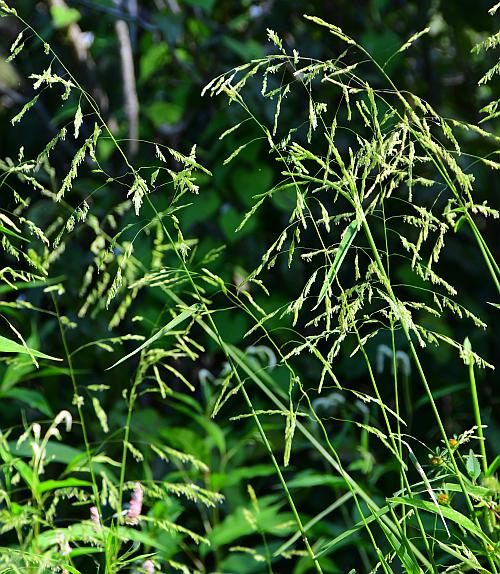Leersia oryzoides (L.) Sw.
Rice Cutgrass

Native
CC = 3
CW = -5
MOC = 76
© SRTurner
Leersia oryzoides (L.) Sw.Rice Cutgrass | |
 |
Native CC = 3 CW = -5 MOC = 76 |
© SRTurner |
|
Family - Poaceae/Oryzeae Habit - Rhizomatous perennial grass. Stem - Flowering stems 50-170 cm long, mostly spreading, circular in cross-section or nearly so, the joints hairy.
Leaves - Sheaths roughened with minute stiff, spinelike, downwardly pointed hairs. Leaf blades 10-30 cm long, 6-15 mm wide, the surfaces strongly roughened with minute, stiff, spinelike hairs, the margins noticeably sawtoothed with stiff, spinelike hairs.
Inflorescence - Open panicles with spreading, spikelike branches. Lowermost branches 2-4 per node, with strongly overlapping spikelets oriented toward one side of the branch.
Spikelets - Spikelets 4-7 mm long, 1.5-2.0 mm wide, strongly flattened, oblong to narrowly elliptic, 2.5-4.0 times as long as wide, the lemma and palea with an "eyelash-like" fringe of hairs along the keel and other nerves, otherwise glabrous. Glumes absent. Stamens 3.
Fruits - Caryopses 3.0-3.5 mm long, uneven in outline. Flowering - June - October. Habitat - Swamps, bottomland forests, sloughs, marshes, fens, streambanks, pond margins, ditches, often emergent aquatics. Origin - Native to the U.S. Lookalikes - L. lenticularis. Other info. - The common name of this grass, "rice cutgrass," is well-deserved. The stems and leaves are covered with retrorse hairs which are tiny, but numerous, stiff, and sharp. These give the foliage a sawtooth aspect which is too small to be seen at a casual glance, but which can be devastating to bare skin. Careless walking through a field having much of this species present will result in a maze of scratches and welts, often deep enough to draw blood, across areas of exposed skin. Knowledgeable hikers and naturalists will venture into wet, grassy fields only with caution, or with all skin covered. The "rice" part of the common name derives from a faint resemblance of the species to rice (Oryza sativa). Photographs taken at B. K. Leach Memorial Conservation Area, Lincoln County, MO, 9-13-2021 (SRTurner). |